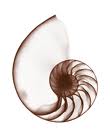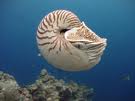Discover the beauty of patterns in the natural world. Look at the structure of a starfish or a chambered nautilus?
 A starfish has five points. If we measured each point of the starfish, would they be the same? Why is a starfish named starfish? Is its shape similar to a star? Does it have the same pattern?
A starfish has five points. If we measured each point of the starfish, would they be the same? Why is a starfish named starfish? Is its shape similar to a star? Does it have the same pattern?
 If we look at the structure of a chambered nautilus, we discover a nearly perfect equiangular spiral. Why does each chamber become increasingly larger as we spiral from the center? Is it because the nautilus as it grows expands its living space, adding more and bigger chambers in an every increasing spiral? The body, of course, would live in the biggest chamber of its “house.”
If we look at the structure of a chambered nautilus, we discover a nearly perfect equiangular spiral. Why does each chamber become increasingly larger as we spiral from the center? Is it because the nautilus as it grows expands its living space, adding more and bigger chambers in an every increasing spiral? The body, of course, would live in the biggest chamber of its “house.”
 Let’s look at the shell’s outer surface. There’s a brown zebra stripe pattern on top and yet the bottom of the shell is white? Why would this be? Nothing in nature is random. The brown zebra stripes on top act as camouflage. Seen from the top by predators, the nautilus blends with the ocean depths. When seen from below, it blends with the light coming from above. Its shell is hard. When the nautilus is threatened by predators, it withdraws into its shell and seals the door. Did you know chambered nautilises existed 265 million years before dinosaurs roamed the earth? These beautiful nautilises are described as living fossils. Why? Because they have remained virtually unchanged for millions of years. So their beautiful design was perfect from the start! In nature, patterns serve a function. Patterns help the animal fool its predators and survive.
Let’s look at the shell’s outer surface. There’s a brown zebra stripe pattern on top and yet the bottom of the shell is white? Why would this be? Nothing in nature is random. The brown zebra stripes on top act as camouflage. Seen from the top by predators, the nautilus blends with the ocean depths. When seen from below, it blends with the light coming from above. Its shell is hard. When the nautilus is threatened by predators, it withdraws into its shell and seals the door. Did you know chambered nautilises existed 265 million years before dinosaurs roamed the earth? These beautiful nautilises are described as living fossils. Why? Because they have remained virtually unchanged for millions of years. So their beautiful design was perfect from the start! In nature, patterns serve a function. Patterns help the animal fool its predators and survive.
Our innate curiosity leads to discovery. Stimulate your child’s curiosity by pointing out patterns in the natural world. Explore the wonder of nature with your child.
Although we now have the internet and can look up anything to explain the mysteries of nature to our children, for a young child there’s nothing like books or magazines with photographs and illustrations to captivate his/her imagination. A child turns the page at his own pace. Best of all, he/she is there cuddled up with mom or dad.
Images from thehealingsprial.co.uk, belljarblog.wrodpress.com and huronscuba.com.
